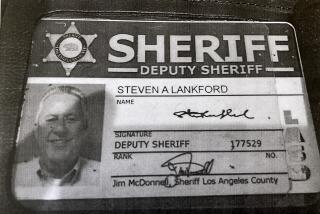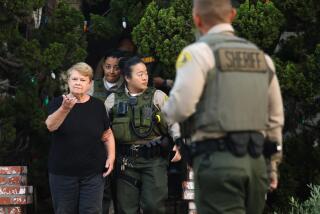Navy Thefts Probe Delayed by Agencies’ Turf Battles
- Share via
SAN DIEGO — Federal authorities received a detailed tip in March, 1983, describing the theft of sensitive Navy aircraft parts for sale to Iran but the resulting investigation was slowed by numerous setbacks, The Times has learned.
The problems included a series of turf battles among U.S. Customs, the FBI and the Naval Investigative Service, according to records on file in federal court here and interviews with sources close to the investigation.
Two letters, one sent to Customs and another to the FBI, included the names of two of the alleged conspirators, that they were obtaining the stolen F-14 fighter plane parts from Navy personnel, and a description of how they communicated with an Iranian agent in London.
Yet, federal investigators did not intercept a shipment of F-14 fighter plane parts until December, 1984--21 months after they received the anonymous letter. During that period, 18 shipments of aircraft parts were sent by the suspects to the Iranian in London, court documents show.
Court records also show that Franklin Agustin and his wife, Julie, the suspects named in the letter, did not employ sophisticated methods or go to elaborate lengths to cover their activities. While the Agustins allegedly made the shipments under the names of fictitious companies, they personally carried boxes to the freight shipping company, used their own addresses for the mailing, spoke openly on the telephone about their operation and used personal bank accounts for transactions involving other alleged conspirators.
Although both the FBI and U.S. Customs received the tip, the FBI did not act for nine months and then dropped out of the case after a brief preliminary investigation concluded that there was no evidence of a smuggling operation.
“It comes right down to a manpower situation and an anonymous letter that couldn’t be corroborated at the time,” said Gary Penrith, special agent in charge of the FBI’s San Diego office.
Customs officials, however, continued the probe. After developing the case for nearly two years, Customs agents were dismayed early this year when they were directed by the Justice Department to bring the FBI back into the case. Customs investigators wanted to wiretap the suspects’ telephones, but were told that they had limited authority for phone tapping and needed the broader jurisdiction of the FBI.
At the same time, Customs officials kept Navy investigators in the dark about the probe because they feared details of the smuggling operation might leak to Navy personnel involved in the theft ring, these sources said.
Language Barrier
The Customs probe also was hampered by the inability of investigators to cultivate confidential sources and a shortage of agents who understood the Filipino dialects used by the suspected ring members, according to documents filed in court by investigators.
An attempt by a Customs undercover agent to infiltrate the ring and learn more about the suspects was foiled by the surprise arrest July 12 of Iranian national Saeid Asefi Inanlou as he boarded a flight to France at London’s Heathrow Airport.
Inanlou’s capture by British authorities forced federal agents in San Diego to expose the ring the same day and arrest four suspects. They were Franklin Agustin, 47; his brother Edgardo, 45; Pedro M. Quito, 60, a retired sailor who was a Navy civilian warehouse worker, and Primitivo B. Cayabyab, an aviation storekeeper aboard the aircraft carrier Kitty Hawk.
In the following days, Julie Agustin, 46, and Antonio G. Rodriguez, a crewman on the amphibious assault ship Belleau Wood, were arrested. Inanlou is free on $150,000 bail and the rest are being held without bail on charges of conspiracy to transport and sell stolen aircraft parts.
The court affidavits, comprising several hundred pages, were filed by the U.S. Attorney’s office in U.S. District Court in San Diego between April 3 and July 2 in support of continued wiretapping of the Agustins’ telephones. They remained sealed until Thursday.
Despite the many problems encountered by federal agents, one source close to the case said he considered the investigation a success.
Called Coordinated
“Just getting agencies to cooperate and share files, men and equipment is a big deal,” said the source, who spoke on condition that he not be identified. “This is the first time two agencies collaborated in an investigation of this type with wiretaps. When you look at the grand picture, the operation was remarkably coordinated.”
The investigation began when Customs and FBI agents received the anonymous letters in March, 1983. The tip stated that Julie Agustin was buying stolen aircraft parts from ex-Navy personnel and shipping them from Los Angeles to the Middle East via London. The letter said the parts were being taken from “a San Diego naval base” and that the buyer in England was shipping them to Iran. The letter provided Julie Agustin’s address, a description of her Volkswagen van and information that she and her husband used a telex machine in Canada to communicate with “a buyer” in England.
The letters, postmarked in Los Angeles, were assembled from words clipped from newspapers and magazines and pasted on paper. Investigators never determined who sent the letters.
The FBI took no immediate action based on the letters.
Customs agents, tip in hand, plowed through the previous year’s billing records for each of four San Diego air freight companies, but were unable to find a shipment sent by Franklin or Julie Agustin.
Phillip Halpern, the assistant U.S. attorney prosecuting the case, said that Customs agents were stymied by the identities of the two fictitious companies allegedly set up by the Agustins to ship the parts to London. He said that it was not until November, 1984, that agents learned about the fictitious company, Ward International and Pierre Walter Ltd.
Break in Case
However, federal sources told The Times that Customs agents learned about the companies earlier in the investigation.
These sources said Customs agents learned about the fictitious firms by late summer of 1983 when they coordinated their investigation with British Customs.
The first break in the case came when Franklin Agustin telegraphed Inanlou in May, 1983, in London to alert him that a shipment of “auto parts” was coming, sources said. The telegram was billed to Julie Agustin’s travel business, Town & Country Travel in National City, and signed “Frank.”
In July, 1983, Franklin Agustin sent a 39-pound package to Inanlou using Pierre Walter Ltd. as the shipping company and Franklin Agustin’s Bonita post office box number as the return address. This was the first time Customs agents learned about Pierre Walter Ltd. and tied the fictitious firm to Franklin Agustin, according to the sources.
While Customs continued to investigate the shipping transactions, the FBI, after nine months of inaction, conducted several interviews in January, 1984, to determine whether the case was worth pursuing. They decided it wasn’t.
The following December, Customs intercepted the first shipment and thereafter regularly opened shipments in San Diego, rewrapping them to avoid arousing suspicions, sources said. According to the affidavits, agents intentionally damaged particularly sensitive parts before sending them to London.
Sought Wiretaps
In January of this year, Customs sought permission from the Justice Department to place wiretaps on the Agustins’ telephones, but were instructed they needed to go back to the FBI, which holds greater wiretap authority. This move angered Customs agents who had worked hard to develop the case after the FBI declined to participate, federal sources said.
Nonetheless, in January the three agencies--Customs, the FBI and the Naval Investigative Service--began coordinating their efforts for the first time. Dozens of Customs and Naval Investigative Service agents were used around the clock to follow Franklin and Julie Agustin.
Known Shipments
In all, court documents list 26 “known” shipments containing 60 cartons. Eventually federal investigators searched eight shipments and recovered more than $2.5 million worth of military equipment.
The wiretaps were approved by a federal judge in April but initially were of no help because most of the ring members spoke Tagalog and Pompango, two Filipino dialects. The language barrier proved substantial because Customs had only one agent who spoke Tagalog and the FBI had none.
Authorities arranged swearing-in ceremonies to make deputies out of several federal employees in other agencies who spoke Tagalog and Pompango.
After declining to use undercover agents for months out of fear that the move might expose the investigation, federal authorities finally decided in June to try to infiltrate the ring by placing someone inside the Navy supply system.
Customs authorities dismissed any thought of using Naval Investigative Service agents, a technique commonly used by Navy officials to expose theft, according to federal sources. Customs officials had failed to notify the Navy of their probe until early this year because they feared that the Navy personnel involved might be tipped off, federal sources said.
Times staff writer Ralph Frammolino contributed to this story.
More to Read
Get the L.A. Times Politics newsletter
Deeply reported insights into legislation, politics and policy from Sacramento, Washington and beyond. In your inbox three times per week.
You may occasionally receive promotional content from the Los Angeles Times.










